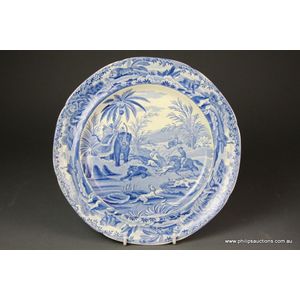Blue and White Mason's Ironstone Plate with Floral Pattern
You must be a subscriber, and be logged in to view price and dealer details.
Subscribe Now to view actual auction price for this item
When you subscribe, you have the option of setting the currency in which to display prices to $Au, $US, $NZ or Stg.
- Circa - A Latin term meaning 'about', often used in the antique trade to give an approximate date for the piece, usually considered to be five years on either side of the circa year. Thus, circa 1900 means the piece was made about 1900, probably between 1895 and 1905. The expression is sometimes abbreviated to c.1900.
- Ironstone China - Credit for the invention of ironstone china is generally accorded to Charles Mason in 1813. Charles Mason was one of the two sons of Miles Mason who founded the Mason works in 1802, and ran the business with his brother George Mason.
Ironstone was a heavy hard earthenware which was slightly translucent, its strength supposedly coming from a very small quantity of iron slag added to the mixture. The additional strength enabled the company to make larger objects that were not susceptible to breakage.
The company manufactured dinner wares, toilet sets, tureens, jugs and so on, and the most popular patterns were blue and white, floral and Oriental Imari style colours.
The trade name "Patent Ironstone China" was registered by the company in 1813, but the patent was only valid for 14 years and was not renewed, enabling other potteries to use the word "ironstone" in describing their wares.
Mason wares are generally well marked with "Mason's Patent Ironstone China" .
This item has been included into following indexes:
Visually similar items

A Spode Pearlware plate, circa 1820, in blue and white 'Lucano' pattern, featuring a vegetal rim comprising fruits of the summer harvest and a central scene of a castle with a bridge; impressed Spode mark and number 30 underside, diameter 21 cm

Early/Mid-18th century Chinese export blue and white rockery and flowers plate. Diameter 23.5 cm

A Rogers blue and white pearlware plate, early 19th century, after Spode's 'Blue Italian' design, with a central scene surrounded by a mixed decorative border with flora and patterns; a single blue 'V' mark underside. Diameter 25.5 cm

A rare Spode Indian Sporting series plate, circa 1810, 'Death of the bear', in an all over blue and white print depicting a colonial hunt of a bear, the rim with a continuous scene of exotic animals amidst lush foliage; with impressed Spode mark underside
